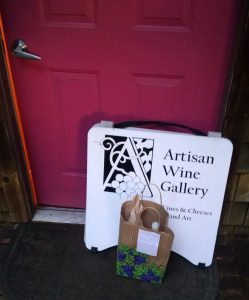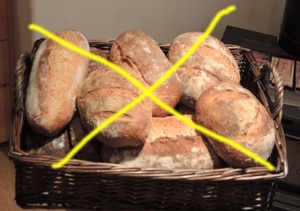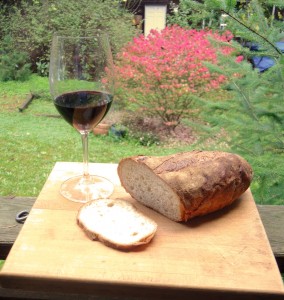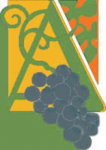lummi island wine tasting march 22-23 ’24
Spring Hours

Fridays 4-6 pm
Saturdays 3-5 pm
This week’s wine tasting
San Martin Les 37 Rose ’21 $16 France $16
Syrah, Grenache and Mouvedre. Fresh and fruity, light and delicious; rich pink in color with bright, floral, fruity nose; fresh and substantial on the palate with good length and crisp minerality on the finish. Ah, Spring is here!
Lievlud cab sauv $16 South Africa $16
Inky purple/blue with plummy aromas of blackberry, blueberry, and cassis with nuances of chocolate and spice with lingering palate of blueberry and plum on the well developed tannins and a spice on the finish.
Torbreck Woodcutters Shiraz Australia $26
Succulent, rich aromas of dark berries and black plum with notes of sandalwood, rosemary and thyme; palate shows
soft tannins and structured, voluptuous mouthfeel from plump Shiraz berries gives this young vineyard the poise and piquancy we expect from this well-established producer.
Friday Bread Returns Next Week

Our baker is traveling this week ( annual baseball spring training trip, we hear…), no bread orders or deliveries this week.
If you are already on the mailing list you should receive the bread/pastry menu for next week by email on Sunday.
Island Bakery has developed a lengthy rotation cycle of several dozen breads and pastries. Each Sunday Janice emails the week’s bread offering to her mailing list. Orders received before Wednesday will be available for pickup at the wine shop each Friday from 4:00 – 5:30 pm. Go to Contact us to get on the bread email list.
Economics of the Heart: An Embarrassment of Villains
Pt 1: Even Avalon Has Its Challenges
Tuesday this week marked the end of our nearly two-year Island discussion with the County about the division of ferry cost burdens between the County-wide Road Fund and the narrowly-defined-by-statute “ferry fare box fund.” Tuesday evening the Council essentially dismissed our position entirely in favor of the County Executive’s order to go ahead and charge fare revenues for $800k of major capital renovations and cut off public insistence that such expenses are definitely NOT “regular and routine maintenance” and cannot legally be charged against fare revenue. Rather, we have argued, they must be paid from the broader County tax base along with other depreciable assets.
The upshot of Tuesday’s decision is that the County can charge any public works costs they want against ferry fares with no oversight whatsoever. (fyi, here’s my own summary of the situation sent to Council members before their meeting on Tuesday.)
Curiously, this Final Defeat is a sort of relief, in the same way as taking a break from banging your head against an impervious wall is a sort of relief. After nearly two years of community effort the Council’s sudden dismissal of islander concerns suddenly leaves us with only one option: filing suit against their flagrant violation of the County ordinance governing what costs may be charged against fares and which can’t. It’s not complicated.
But there is a sense of relief to get it, to feel it, that “resistance HAS been futile,” and that a court is the only available arbiter of the law. Stay tuned…
Pt 2: Glimmers of the Coming Apocolypse
The other issue is one we have been discussing over the last few months: the powerful and dangerous coalition of ultra-wealthy, ultra-corporate, ultra-religious conspirators who are close to realizing their socio-political wet dream of transforming the United States into an Ultra-Conservative Christian Autocratic State controlled by merciless, white, wealthy “Christian” men. These men will assume complete authority over who lives and who dies, who will have dignity and who will be punished and persecuted, who will rewarded and elevated, who will be shamed, beaten, tortured, and murdered…you know, the basic Authoritarian Recipe Book.
These are the same people who have taken over our Supreme Court, the Republican Party (or what is left of it), and become billionaires. (see this very well-constructed series of talks by Senator Sheldon Whitehouse of RI.) They are the same people taking away the rights of women, non-whites, and immigrants. They either do not believe or care about individual freedom or dignity, global warming, ecosystem protection, education, health care for all, or the assertions of the Declaration of Independence that every human is endowed by our Creator with inalienable rights.
We have also discussed recently how think tanks like the Heritage Foundation, which were already “conservative,” have in the past couple of years turned very sharply to the Very Far Right, are committed to bringing the Tweetster back into power, breaking our country away from our historical allies around the world, and emulating authoritarian states like Russia, Turkey, Hungary, and Saudi Arabia. And of course we have all heard the Tweetster’s promises to gut the entire federal civil service force and replace them with boneheaded authoritarian bullies with the intelligence of slice of tofu.
Folks, these are grave and deeply disturbing developments. While we watch the meltdown of the Tweetster, these Far Right agents seem intent on launching their “revolution” soon, this year, and taking over, with him or without him. The current obvious implosion of the Tweetster side be side with the continuing consolidation of power by the enemies of democracy in our country are not and never have been about the Tweetster. He has just been their wiling barker, and he did his job well: his follower are all now in a deep trance, reinforced 24/7 by cable news and talk radio.
All our lives we have accepted that periodically whole populations of sweet little lemmings, for no particular reason, commit mass suicide by throwing themselves off perfectly supportive cliffs into a deadly ocean. Why? Common hysteria? Drugs? Jumped or Pushed? Can we believe the story pushed by the handful of survivors (naw, they wuz crazy, man, they just jumped…)
So here we are with a growing population of people being brainwashed online to believe that liberal thought is their enemy, that freedom of anyone is a danger to everyone. Therefore, it seems reasonable to be curious about how we can respond as a community, a State, a nation (or a County!) to this level of psychoemotional manipulation by a 24/7 audio-visual barrage of lies, from well-funded, predatory manipulators now 30 years down their road to abolish liberal thinking completely. Just like 1984. Only way worse!
On that note, a reminder we are now on Spring hours, open Friday (4-6) and Saturday (3-5) for wine tasting, sales, and conversation.
Y’all come on by now, heah…?
lummi island wine tasting mar 2-3 ’24
Spring Hours
- Fridays 4-6 pm
- Saturdays 3-5 pm
ahh, more signs of spring…
This week’s wine tasting
Bodega Garzon Albarino ’21 Uruguay $15
Pale yellow with greenish reflections, this Albariño is intense in the nose, with peach and citrus notes. The freshness and minerality mid-palate is superb, with remarkable acidity and a round, crisp finish. A lovely wine at a bargain price!
Angeline Cab Sauv ’21 California $16
Fruit-forward, easy-to-drink style with aromas of lush cherry, cassis, and plum and rich cherry and plum flavors with hints of vanilla and soft oak that linger on the palate and finish with complexity and length that over-delivers for the modest price.
Marchetti Villa Bonomi Conero Riserva ’19 Italy $27
100% Sangiovese from Montepulciano, aged 16 mos. in barriques and 12 mos. in bottle; shows intense floral bouquet, intense, nuanced flavors; ripe, pleasing tannins, and satisfying finish.
Friday Bread Pickup This Week

Pain au Levain – Made with a nice mix of bread flour and freshly milled whole wheat and rye flours. After building the sourdough and mixing the final dough it gets a long cool overnight ferment in the refrigerator. This really allows the flavor to develop in this bread. A great all around bread – $5/loaf
Cinnamon Raisin – Made with a poolish of bread and fresh milled rye flour that is fermented overnight before the final dough is mixed with bread flour and freshly milled whole wheat as well as rolled oats. Some honey for sweetness, a little milk for a tender crumb and loaded with raisins and a healthy dose of cinnamon. This is not a rich sweet bread with a swirl of cinnamon sugar, instead the cinnamon is mixed into the dough and flavors the entire bread. It is a hearty rustic loaf. Great for breakfast toast, even better for french toast – $5/loaf
and pastry this week…
Individual Cinnamon Rolls – Made with a rich sweet roll dough full of eggs, butter and sugar. The dough is rolled out, spread with pastry cream and sprinkled with cinnamon sugar. Then rolled up and sliced into individual rolls for baking. And boy are they delicious!! – 2/$5
Island Bakery has developed a lengthy rotation cycle of several dozen breads and pastries. Each Sunday Janice emails the week’s bread offering to her mailing list. Orders received before Wednesday will be available for pickup at the wine shop each Friday from 4:00 – 5:30 pm. Go to Contact us to get on the bread email list.
Economics of the Heart: The Ominous Resurgence of Vapid Pragmatism

“Newt Gingrich and Donald Trump – Caricatures” by DonkeyHotey is licensed under CC BY-SA 2.0.
Let’s face it, the world is going to Hell around us. And the forces pushing it there have been morphing since the Sixties, from Nixon to Reagan, Bushes I and II, and the Tweetster. You will recall that all of them, under the auspices of economic freedom, found ways to withhold federal money for the poor, the sick, the disturbed. The needy of all stripes were systemically thrown off the bus, out of the lifeboat, or onto the streets to fend for themselves. “No sir, no more aid for “welfare queens,” those single moms with five kids, ripping us off for another pack of cigarettes as they tried to house and feed a family. Seriously, that was a thing in Gov. Reagan’s California in the late 60’s.
Indeed, the sixties began an ever-evolving system of reactionary “backlashes” against interlopers who might cross unmarked class boundaries, including a range of heterosexual, homosexual, ethnic, gender, or self-sufficiency credentials. And let’s include the many ways White Republicans responded to the Obama Presidency.
Fast forward to today, and we see the Tweetster slipping out of the many sets of cuffs he so richly deserves because he is self-entitled to Special Privileges, like grabbing women by private parts, stripping rights from everyone who is not a white, Christian, America-born male, and bending every rule, every principle, every guideline of integrity to acquire one more penny, bit of influence, advantage, or perk, even from (perhaps “especially from”) those who have been disadvantaged by the same rules that have advantaged them.
We see this across the Red States and across the world in countless local hierarchies of “star-bellied sneetches” vs. “plain-bellied sneetches.” It’s the way we are or what we become if we don’t have an effective magnet in our moral compasses.
This all comes up tonight after attending yet another unproductive ferry committee meeting with County Public Works, which conducts the financial levers of costs vs. fare revenues in a consistently opaque way. So tonight’s insight is that, “ah, we finally get it that when you serve Whatever Company, public, private, or government, your loyalty is increasingly to the Company and its parochial interests, not to some broader principle of service or equity or fairness or justice to, you know, the collective welfare.
It is always a disturbing disappointment to encounter these petty or self-serving loyalties, evasive rationales, or deliberate prevarications in a dialogue aimed at achieving a common purpose. So we need constantly to distinguish in any particular moment when we are acting from principle and when we are acting from expediency.
lummi island wine tasting ides of March ’24
Spring Hours
- Fridays 4-6 pm
- Saturdays 3-5 pm

ahh, more signs of spring…
This week’s wine tasting
Bodega Garzon Albarino ’21 Uruguay $15
Pale yellow with greenish reflections, this Albariño is intense in the nose, with peach and citrus notes. The freshness and minerality mid-palate is superb, with remarkable acidity and a round, crisp finish. A lovely wine at a bargain price!
Angeline Cab Sauv ’21 California $16
Fruit-forward, easy-to-drink style with aromas of lush cherry, cassis, and plum and rich cherry and plum flavors with hints of vanilla and soft oak that linger on the palate and finish with complexity and length that over-delivers for the modest price.
Marchetti Villa Bonomi Conero Riserva ’19 Italy $27
100% Sangiovese from Montepulciano, aged 16 mos. in barriques and 12 mos. in bottle; shows intense floral bouquet, intense, nuanced flavors; ripe, pleasing tannins, and satisfying finish.
Friday Bread Pickup This Week

Pain au Levain – Made with a nice mix of bread flour and freshly milled whole wheat and rye flours. After building the sourdough and mixing the final dough it gets a long cool overnight ferment in the refrigerator. This really allows the flavor to develop in this bread. A great all around bread – $5/loaf
Cinnamon Raisin – Made with a poolish of bread and fresh milled rye flour that is fermented overnight before the final dough is mixed with bread flour and freshly milled whole wheat as well as rolled oats. Some honey for sweetness, a little milk for a tender crumb and loaded with raisins and a healthy dose of cinnamon. This is not a rich sweet bread with a swirl of cinnamon sugar, instead the cinnamon is mixed into the dough and flavors the entire bread. It is a hearty rustic loaf. Great for breakfast toast, even better for french toast – $5/loaf
and pastry this week…
Individual Cinnamon Rolls – Made with a rich sweet roll dough full of eggs, butter and sugar. The dough is rolled out, spread with pastry cream and sprinkled with cinnamon sugar. Then rolled up and sliced into individual rolls for baking. And boy are they delicious!! – 2/$5
Island Bakery has developed a lengthy rotation cycle of several dozen breads and pastries. Each Sunday Janice emails the week’s bread offering to her mailing list. Orders received before Wednesday will be available for pickup at the wine shop each Friday from 4:00 – 5:30 pm. Go to Contact us to get on the bread email list.
Economics of the Heart: The Ominous Resurgence of Vapid Pragmatism

“Newt Gingrich and Donald Trump – Caricatures” by DonkeyHotey is licensed under CC BY-SA 2.0.
Let’s face it, the world is going to Hell around us. And the forces pushing it there have been morphing since the Sixties, from Nixon to Reagan, Bushes I and II, and the Tweetster. You will recall that all of them, under the auspices of economic freedom, found ways to withhold federal money for the poor, the sick, the disturbed. The needy of all stripes were systemically thrown off the bus, out of the lifeboat, or onto the streets to fend for themselves. “No sir, no more aid for “welfare queens,” those single moms with five kids, ripping us off for another pack of cigarettes as they tried to house and feed a family. Seriously, that was a thing in Gov. Reagan’s California in the late 60’s.
Indeed, the sixties began an ever-evolving system of reactionary “backlashes” against interlopers who might cross unmarked class boundaries, including a range of heterosexual, homosexual, ethnic, gender, or self-sufficiency credentials. And let’s include the many ways White Republicans responded to the Obama Presidency.
Fast forward to today, and we see the Tweetster slipping out of the many sets of cuffs he so richly deserves because he is self-entitled to Special Privileges, like grabbing women by private parts, stripping rights from everyone who is not a white, Christian, America-born male, and bending every rule, every principle, every guideline of integrity to acquire one more penny, bit of influence, advantage, or perk, even from (perhaps “especially from”) those who have been disadvantaged by the same rules that have advantaged them.
We see this across the Red States and across the world in countless local hierarchies of “star-bellied sneetches” vs. “plain-bellied sneetches.” It’s the way we are or what we become if we don’t have an effective magnet in our moral compasses.
This all comes up tonight after attending yet another unproductive ferry committee meeting with County Public Works, which conducts the financial levers of costs vs. fare revenues in a consistently opaque way. So tonight’s insight is that, “ah, we finally get it that when you serve Whatever Company, public, private, or government, your loyalty is increasingly to the Company and its parochial interests, not to some broader principle of service or equity or fairness or justice to, you know, the collective welfare.
It is always a disturbing disappointment to encounter these petty or self-serving loyalties, evasive rationales, or deliberate prevarications in a dialogue aimed at achieving a common purpose. So we need constantly to distinguish in any particular moment when we are acting from principle and when we are acting from expediency.
lummi island wine tasting mar 7 ’24
Spring Hours!
- Fridays 4-6 pm for wine tasting and bread order pickup;
- Saturdays 3-5 pm for wine tasting…and sales…and the usual frivolity and chatter…!
ahquiet enough for conversation…
This week’s wine tasting
Marchetti Verdicchio dei Castelli di Jesi Classico ’22 Italy $14
Verdicchio/Malvasia blend using only free-run juice; pale straw color with green overtones; intense bouquet of citrus, lemon zest, and floral notes,with complex fruity character, and crisp, well-balanced palate.
Cote 125 Corbieres Rouge ’19 France $15
Classic Corbieres blend of carignan, grenache, syrah, cinsault; rich and concentrated with blueberry and strawberry aromas and flavors, with notes of spices and black pepper, good balance, and a long, smooth finish.
Chakana Estate Selection Malbec ’20 Argentina $20
Opaque, bright purple in color; pleasing nose of plums and spicy attic dust; full bodied palate of plums and spice with good length, balanced acidity, soft tannins, and lingering finish.
Friday Bread Pickup This Week

Honey, Wheat, Lemon & Poppy seeds – Made with a poolish that ferments some of the flour, yeast and water overnight. This results in a very active pre-ferment which is mixed the next day with the final ingredients which includes a nice mix of bread flour and fresh milled whole wheat. Some honey, poppy seeds and freshly grated lemon peel round out the flavors. – $5/loaf.
Rye w/ Currants, Pumpkin Seeds & Cracked Coriander – Made with a starter fed with rye instead of wheat flour, the final dough includes bread flour and freshly milled rye flour, some molasses for sweetness and pumpkin seeds, currants and cracked coriander seed make for an interesting flavor profile – $5/loaf
and pastry this week…
Pain aux Raisin – Made with the same laminated dough as croissants; the dough is rolled out, spread with pastry cream and sprinkled with a mix of golden raisins and dried cranberries soaked in sugar syrup,and rolled up and sliced before baking. – 2/$5
Island Bakery has developed a lengthy rotation cycle of several dozen breads and pastries. Each Sunday Janice emails the week’s bread offering to her mailing list. Orders received before Wednesday will be available for pickup at the wine shop each Friday from 4:00 – 5:30 pm. Go to Contact us to get on the bread email list.
Economics of the Heart: Authoritarian Followers

Trump-26 by TaylorHerring
We all either already knew or have been learning about authoritarian leaders, and we pretty much get it: they are only okay when they are in complete charge of everyone else. But why anyone would believe, follow, support, or agree with these people is a total mystery to many of us. So who are these people who line up for Tweetster rallies, send him money, threaten anyone who doesn’t back him, get all their “facts” from Fox News and talk radio, and apparently sin as much as anyone else but don’t let themselves enjoy it or admit it to anyone.
It turns out that the personality of the authoritarian leader is quite different from that of the followers. While the authoritarian leader is driven by a sense of “I’m only okay when I have absolute control,” social psychologist Bob Altermeyer studied the followers of such people for many years and found they share several traits and beliefs:
- A willing submissiveness to those they accept as established and legitimate authorities;
- Ongoing general aggressiveness against people they perceive to be sanctioned (against) by established authorities; and
- A high degree of adherence to the narrow social conventions they perceive to be endorsed by those they accept as established authorities.
So for the followers there seems to be a lot here about “I’m only okay when someone very strong is in complete control,” but to a lot of us that sounds like something “devoutly to be eschewed,” as one old sailor once said about being in a hurricane in a sailboat.
The dynamic between the authoritarian leader and his (usually) followers is that he gives them both license and approval for physical aggression against those who are perceived as inferior and nonconforming in various ways. They share an unspoken ethos that the most nonconforming deserve the worst punishments, the most powerful deserve the most deference, and apparently, that delivering punishment to those the leader pegs as “enemies” is irresistible. (picture the mob-mind at the Capitol on Jan 6…)
Curiously, these followers also share a narrow conventionalism about how people should behave, even in their private lives. In that sense, many are religious fundamentalists, with limited abilities to discern or perhaps even imagine shades of gray. In this sense they seem deeply imprisoned by the absolutism of their beliefs.
We close tonight with a few interesting related research findings for the US:
— Authoritarian voters have generally preferred Republican leaders;
— Tweetster supporters are substantially more likely than other Republicans to score highly on authoritarian aggression and group-based dominance; and
–Authoritarianism is different from Conservatism because authoritarianism reflects aversion to differences across space (i.e. diversity of people and beliefs at a given moment) while conservatism reflects aversion to changes over time.“
We all see and feel these deep divisions in our country about very basic values of what is true or not true, good or bad, desirable or undesirable, fair or unfair, right or wrong, and find it puzzling that there could be such broad disagreement about such fundamental perceptions.
On reflection it seems extremely unlikely that these nation-threatening divisions just happened by themselves. It seems more likely that a lot of deliberate effort has gone into fostering and promulgating them across our country for many years toward our downfall and their ascension. Creepy stuff…!
(We started this piece by looking at this item in Wikipedia, and found it so interesting it’s as far as we got…)

 2072 Granger Way
2072 Granger Way